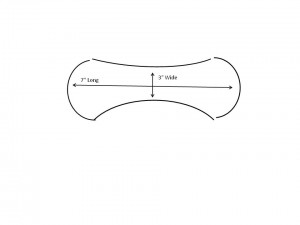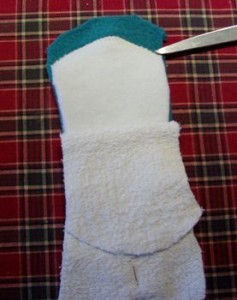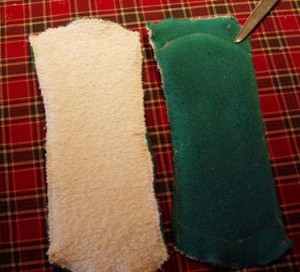Are we sustainable yet?
And now, Aunt Toby is going to discuss something ‘ooky’ – which is personal sustainability. No, not the ‘in the kitchen’ sort – this is the ‘in the bathroom’ sort.
One statistic out there claims that at least 1/3 of all sanitary napkins (or “Kotex” or ‘pads’ if you will) purchased in the US are bought by women who haven’t had a period in a very, very long time. The manufacturers know this – it is not a secret to them. If you look at the packaging, look at the descriptions of the ‘anti scent strips’ or the absorbency ratings that they are putting into the napkins. This is not just for women who feel that their menses have an odor, believe me. This is for women who have one of the forms of incontinence and who are not ready to either move to a more absorbent product or go see their urologist or OB-GYN to start discussing surgical intervention.
A lot of women have that ‘when I cough or sneeze’ issue, so they wear a pad pretty much all the time. Which means that women who are using pads for that problem are wearing 2-3 pads a day, 365 days a year and then disposing of them into the trash, which goes to the landfill.
If you have feelings about using disposable diapers (which I do – I used old fashioned cloth diapers on my kids 30 years ago), there is a bit of a logical mis-match about sending 750-1000 sanitary napkins to the landfill for several decades. Even babies only use diapers for 2-3 years.
So, wanting to be cutting edge about this and looking at what is not exactly new but from this grandmother’s viewpoint is pretty exciting stuff, I’ve been looking at all the very entrepreneurial folks out there on the internet who are offering cloth diapering ‘systems’ (or, actually, a washable water resistant outer pant which closes with snaps or Velcro™ and various sorts of absorbent pads, which also snap or adhere to the inside pant. Very clever stuff. There are also businesses which offer patterns for making your own and various sorts of absorbent fabrics and materials to make them. If you can sew a seam on a sewing machine – they are a slam dunk. For more information on this sort of thing, search on ‘cloth diapering systems’.
Another site (which specializes in these fabrics), also offers a new sort of hyper-absorbent material, called Zorb™, which comes in a couple of absorbencies and in yardage and in already cut out blanks for these diapering systems (just add your top thin absorbent layer and a bottom fleece layer, sew everything together and voila!). And since I was going to buy some of the blanks in various sizes to make cloth diapers for a grandchild that I am watching, I figured that the smallest size of the absorbent blanks would be a good buy (since I am not interested in making a zillion of these and can cut the blanks into a couple of smaller pieces to make my own ‘sanitary napkins’). For more information on Zorb(tm): Wazoodle
Now, I’m using fleece and terry that I already have in my (seemingly ever-growing) stash; if you don’t have stash, I’d say that using an old terry cloth bath towel and perhaps some other thin breathable fabric on the bottom would work well. If you have some sort of thin poly fleece or even an old tee shirt, that is really best. I am not pushing using something like vinyl or plasticized fabric. I’m not sure why but it sure doesn’t have a whole lot of appeal for me.
Also, let’s say you don’t want to go to the point of buying any of this hyper-absorbent fleece – here is what I would do. Nature has given us her own ‘hyper-absorbent’ fiber – it’s called sheep’s wool. So, if you have an old sweater (nothing too heavy – a light weight cardigan or pull over will be the right weight), throw it into the washer with soap and the hottest water you can get, wash, and then rinse in cold water. That will shock the fibers and felt them. That will be your absorbent layer and when you have finished your sanitary napkins, you will be able to wash these in the washer – they won’t shrink up any more. Sheep’s wool can absorb 40% of it’s own weight in liquids so this is a pretty good substitute.
OK – so here is how I am doing this:
 I made myself a pattern that looks pretty much like the shape of a sanitary pad – 3” wide in the center, where the pad curves in (to fit inside my underwear) and 7” long (see the diagram). I use that one to cut out the ‘hyper-absorbent’ layer (either something like Zorb™ or a felted sweater. Then using the same pattern, I cut out a top layer (either out of an old tee shirt or thin terry cloth), but I make it 1” longer at both ends AND I cut out a bottom layer of poly fleece and again, I make it 1” longer at both ends. So now I have a top layer, a bottom layer and an absorbent layer.
I made myself a pattern that looks pretty much like the shape of a sanitary pad – 3” wide in the center, where the pad curves in (to fit inside my underwear) and 7” long (see the diagram). I use that one to cut out the ‘hyper-absorbent’ layer (either something like Zorb™ or a felted sweater. Then using the same pattern, I cut out a top layer (either out of an old tee shirt or thin terry cloth), but I make it 1” longer at both ends AND I cut out a bottom layer of poly fleece and again, I make it 1” longer at both ends. So now I have a top layer, a bottom layer and an absorbent layer.
Step 1: Take the hyper-absorbent layer piece and center it on the bottom layer and zigzag at the top and bottom. Make sure that at the sides, if any of the hyper-absorbent stuff hangs outside and bottom layer, you carefully trim that back so that the edge is INSIDE the bottom layer. In the photo, you can see that the point of the scissors is pointing at the zigzagged edge over the hyper-absorbent layer and the terry is on top (folded back so you can see all the layers).

Step 2: Take the top layer and lay that on top of the hyper-absorbent layer (this means that at the end, the top will be terry or tee shirt and the bottom will be fleece, ok?). Pin this all together and zigzag all around the edge. Trim off any odd threads or not even edges. The last photo shoes two of this, with the opposite sides showing.
Voila! A very absorbent sanitary napkin that will take care of any of the ‘cough and sneeze’ issues and will not end up in the landfill. You get the Good Citizen’s Award.
 How to take care of these. Believe it or NOT, there was a ‘feminine hygiene world’ before tampons and sanitary napkins (which according to my mom, were invented in WWII), and believe it or not, what women used in those days was…pretty much what I’m describing here, though they used to fasten them into their underwear with a safety pin (I don’t seem to have any issues keeping these in my undies but if I did, I might think about double sided tape, frankly..). And when they changed them, they (oh, the horror!) used to rinse them all out and wash them. Yep – they had to handle their own body fluids. We’re all big girls here – we can do that too. It’s only a little pee, ladies…and if you are, ahem, younger and are still getting the monthly ‘visit’ (as we used to say), well, good gosh almighty – you can use these for that too, but to wash them, here’s a little secret I learned for how to take blood out of my uniform when I used to work in the hospital (don’t ask): soak them in cool water with a little bit of salt in it – universal solvent for blood is…saline solution, and that will get the monthly flow out of the pads before you throw them in the wash.
How to take care of these. Believe it or NOT, there was a ‘feminine hygiene world’ before tampons and sanitary napkins (which according to my mom, were invented in WWII), and believe it or not, what women used in those days was…pretty much what I’m describing here, though they used to fasten them into their underwear with a safety pin (I don’t seem to have any issues keeping these in my undies but if I did, I might think about double sided tape, frankly..). And when they changed them, they (oh, the horror!) used to rinse them all out and wash them. Yep – they had to handle their own body fluids. We’re all big girls here – we can do that too. It’s only a little pee, ladies…and if you are, ahem, younger and are still getting the monthly ‘visit’ (as we used to say), well, good gosh almighty – you can use these for that too, but to wash them, here’s a little secret I learned for how to take blood out of my uniform when I used to work in the hospital (don’t ask): soak them in cool water with a little bit of salt in it – universal solvent for blood is…saline solution, and that will get the monthly flow out of the pads before you throw them in the wash.
And how long does this take? OK, for you folks who are convenience buffs, I can tell you that cutting out and sewing these, soup to nuts – I did two in 10 minutes, total. That means that with a bit of planning, anyone could set themselves up a whole week’s worth of these sorts of sanitary supplies in a couple of hours. And if a couple of people wanted to get together on a Saturday afternoon and really do this factory style..well, it’s almost unbelievable how many of these could be produced. And how many disposable sanitary napkins can be kept out of the landfills.

And what about using these as a menstral pad? There’s several options out there, and it’s so taboo to talk about..
Steph – Yep – same exact deal. Pin them into your undies, use double sided tape, or just put them in there but they will work. The only thing is that you might want to soak them in some salt water to get the blood to release before you put them in the washer. All the same.
We’ve already forgotten that this is what our great-grandmothers – and all the bazillion generations before them – did.
I’ll be the one who points out that the rinse water can be dumped into your compost, whether you are rinsing out pee or blood. 🙂
I have never soaked my cloth pads in saline though. Can’t say I’ve ever been too worried about a bit of staining in them. I just rinse in a bucket of water, wring out, then pop into the laundry. The bucket of rinse water goes out to the compost pile…
Wolfie — that’s for a ladies who need a little encouragement to do this, to get beyond the whole ‘out of sight/out of mind’ disposable thing. After a while, they might not want to bother with the saline either, but for them, I was trying to help them over the ‘ooky’ factor.
No more ooky, really, than baby poop or dog puke, which we’ve all cleaned up. Or the months when we might just as well have turned ourselves inside out and gotten it over with. ;-p Mmmm: bodily emissions…. Ah, but ooky is in the mind of the beholder!
I do forget about those who have the ooky factor in their minds…sometimes I am surprised when people are grossed out by the by-products our bodies produce. Not that everything is pleasant, just that they are a fact of life.